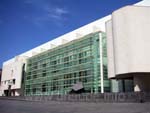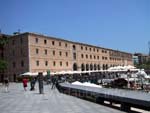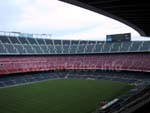|
|
Museums in Barcelona
Most of the visitors of Barcelona get into the dilemma that the city offers some very interesting museums but the time available in Barcelona is much too short and precious in order to visit a museum. The attractive buildings, churchs, parks and view points "swallow" so much time that there is barely time left for a visit to the museum. Actually, one can only hope that a rainy day comes... 
In fact, Barcelona does have such a multifaceted offer of partly top-class museums that one could spend 1-2 weeks merely in the museums. Those who are some longer time in Barcelona should in any case visit one or two museums. Of course, one first considers a rainy day for a visit of a museum. But there are not much of them in Barcelona. A visit to the museum is also recommendable when it is very hot and humid outside. Myself, I had some very good doing relaxing breaks from the sightseeings in a few museums during the hot midday hours thanks to their air-conditioned rooms. Before getting to the museum, one should be informed about the opening times. Many museums are closed on Mondays but therefore opened during the week-end. Many museums also have a midday break, thus for example between 02.00 and 04.00 p.m. In the following I will introduce some museums that I specially liked and that are not considered at first as a mormal tourist. Museu d'Història de la CiutatThe Museum of City History of Barcelona is not a city museum like there are in many cities of the world, but something very special: in the Museu d'Història de la Ciutat there is for a moderate entrance fee of 3 € city history to touch, in the truest sense of the word. The museum is located in a Gothic palace that had been moved in the year 1931 from its original place at the Plaša del Rei. During the excavations people came across to the remainings of the 2000 year old Roman city. These were exposed and can be visited today. In the Museu d'Història de la Ciutat one takes immediately a lift downwards to the past. In the cellar of the museum, one walks on a firm path in the aged Barcino. The are 2000 year old city walls and city towers to touch. One practically walks on a part of the antique Barcelona. Some detailed tablets show continuously which part of the old Barcelona is currently in front of one, from the thermae facilities to the city wall up to the laundry or winery. There are not many places in this world at which one gets such a deep and detailed insight of the past of the Roman times. What is specially fascinating is that one can walk through the subterranean corridors up to the cathedral of the oldtown. Additionally, the museum offers some Exhibitions of the medieval times; but these are never so interesting as the antique city in the basement. The Museu d'Història de la Ciutat should be experienced in any case, also if the visit to Barcelona is short. At the Plaša del Rei, one in any case cannot avoid visit the oldtown and the well worth seeing antique city parts in the cellar of the museum can be seen rapidly. But the old walls and rooms fascinated me so much that I needed some hours to assimilate everything. Museu de l'Història de CatalunyaThose who are interested in the history of Barcelona and Catalonia can walk for hours through the museum for Catalan history. I specially liked this museum as I was very fascinated of the history of Barcelona and Catalonia; Not until I visited this museum I really learned to understand this city. 
What does the Museu de l'Història de Catalunya offer? One looks for precious beauties of the past of the city or the country without success. But the history of the country is transmitted in a very clearly and understandable way. Numerous maps make the historical correlation understandable, also for non-expert people. Unfortunalely, numerous inscriptions are only in Catalan language, so that one does not understand very much even by having some knowledge of the Spanish language. The museum is divided in approximatelynbsp;40 sections; each section stands for an historical epoch. At the end of the tour, one gets on a roof deck where a restaurant invites to relax. But what is much more inviting is the impressive view to the harbour and the city that one has from the museum building. The visitor of the museum can relax on one of the numerous seats and couches; as those who walk through the museums for hours get rapidly tired as known. The museum of Catalan history is not an absolute must for a visitor of Barcelona. But I recommend everybody to read a little about the history of Barcelona and Catalonia, even if it is only my detailed page. As with an hostorical background, one sees the city with completely different eyes as if one just visits it just because of interest and fascination. The Football Museum of the F.C. BarcelonaThe museum of the football club F.C. Barcelona is a museum that is rather visited by local people and Spaniards then by tourists. The F.C. Barcelona is not a common football club; it is a club of the superlative. The F.C. Barcelona is the football club with the most members worldwide; the museum is the biggest footbalmuseum; and the stadium is the biggest of the world. 
What is there to see by going to the F.C. Barcelona? The museum is located on two floors. The collection of cups and trophees is bone-crushing. Beside the successes of the club in cups and images, there are also individual items of famous players of the club. Those who always wanted to see the football boots of Bernd Schuster in reality will find them here. The museum goes back to the year of foundation 1890. Also the old kickers in the exhibition hall are fascinating to see. What is at least as fascinating as the museum is the footbal stadium Camp Nou. From the museum, one gets to a part of the grandstand of the stadium. There is to know that this football stadium is the second biggest one of the world with approximately 120.000 seats. It is absolutely impressive to find oneself as a tiny dot in a stadium of such giant dimensions. But what is much bigger than the museum of the football club is the appending shop where all kinds of fan items are sold: concerning its size, this shop beats some of the german department stores of small cities in Germany. Here, specially young people do buy the tricot of their favourite player. As a tourist, does one have to visit the football museum of the F.C. Barcelona? Is such a visit worthwhile? The first question, I will answer with no, but the second one with a huge yes; What actually more impressed me was the huge football stadium Nou Camp than the numerous trophees of the club. Finally, one does not access many times in one's life a stadium that offers space for 120.000 people and that one has already seen sometimes on TV, full of people. Further museums of the cityIn principle, I described the most unimportant museums of the city. Those museums for which Barcelona is really famous and in which the visitor streams flow are:
The Picasso museum is the most visited museum of Barcelona. Picasso lived for 10 years in the Catalan capital. In the Picasso museum there are numerous first-class creations of the artist exposed; but the exhibitions are not merely of Picasso. The Museu Gaudí is located in the Parc Güell; As this park is a must for all visitors of Barcelona, it is unavoidable to pass the residental house of Gaudí. Of course it is a special kick to visit the residential house of the genius, but one learns more about the life and the creations of Gaudí in the Casa Milà. It is also unavoidable to pass the Museu d'Art de Catalunya (museum for catalan arts), as the Palau Nacional on the Montju´c also is a must for all visitors of Barcelona. The museum offers a worldwide unique collection of Roman and Gothic arts. What is specially impressive are the frescos of the Catalan churches form the Pyrenées. The are still umpteem museums in Barcelona, but they are partly only interesting for those who are interested in a specific area like geology or military. 
Copyright: Patrick Wagner, www.tourist-guide.biz |
||